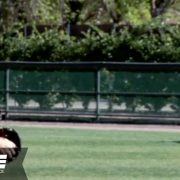Learn How to Throw a Curveball
Remember when you started to learn how to throw a curveball? Did you struggle at first? It doesn’t come easy for everyone. When baseball pitchers struggle to learn how to throw a curveball, I have found that it is often for a couple of common reasons.
First, players often struggle with is getting comfortable throwing the ball with the right hand and wrist position. Throwing a good curveball isn’t about curling or twisting your wrist.
Second, when pitchers first start working on their curveball, they often just start off trying to throw it too hard.
Why are these problems?
See, ultimately when you use it in the game, you do want to throw your curveball with good arm speed and hand speed (or good fastball tempo). But the problem is, if you’re not used to throwing a baseball with the correct curveball hand and wrist position (supinated – palm turned in), chances are you’ll have a tough time maintaining it through ball release. Your hand is going to want to revert back to the way it’s used to throwing.
And this can be bad for a couple of reasons…
First off, you won’t be getting good forward rotation on the ball. Instead of a curveball, you’ll likely end up with a really bad slider. Or, to make up for that bad hand and wrist position, you’ll try to correct by turning or twisting the wrist at the last minute. It’s tough to be consistent this way, and potentially worse for your elbow.
So how do you make sure you’re throwing it the right way?
Learn How to Throw a Curveball
In order to learn how to throw a curveball, you need to reprogram your central nervous system.
I recently made it out to a seminar in Boston where Eric Cressey, Mike Reinold and Tom House all presented. And while I don’t completely agree with Tom House on all of his theories, I think he’s an excellent teacher/presenter and I have a lot of respect for the way he continues to test and challenge conventional wisdom.
House primarily talked about kinematic sequencing, essentially developing good timing in your delivery. The part that was most interesting to me was when he got into the idea of reprogramming movement patterns, or replacing old movement patterns with better ones His main point was that if you want to make lasting changes, you really need to break it down and go back to the early stages of development.
As an example, he cited his recent work with professional quarterback. Basically, the idea is, when working with guys who’ve been throwing for years and playing at a high level, you’re fighting a lot of old programming. So you don’t make changes at the skill level, or even at the muscle/strength level.
You go back to basics and operate at the central nervous system level. The central nervous system is essentially how the brain and spinal cord control the body. Relearn the positions, reprogram the movements. And this is basically the same approach you want to take when learning to throw a curveball, or any other new pitch for that matter.
So if starting by throwing too fast is one of the biggest mistakes you can make, what do you think is a one of the key steps for developing a good curveball?
You guessed it…
Start slow!
Based on this information, here are some guidelines to consider when trying to reprogram your central nervous system to learn how to throw a curveball.
Step 1: Get in Front of a Mirror
To really lock in the feel for good curveball hand and wrist position, start off by practicing it real slow in front of a mirror. That way you can see if you’re really getting that hand turned sideways as you throw, and you can begin to make the connection between what it looks like and what it feels like.
When it starts to feel natural, you’re ready for step 2…
Step 2: Get the Feel for Good Curveball Release
When you start actually throwing the curveball, I recommend getting the feel for ball release first and working backwards from there. So start off real light, about 15-20 feet from your target. I usually like to start guys off facing their target, feet shoulder width apart, toes pointed forward. You can even start out on your knees to take the legs out of it completely (forces you to keep it light). And just get the arm up with that good hand and wrist position, and work on tossing/flipping the ball with good forward spin.
Step 3: Start Getting Your Body Into It
Then, once you’ve gotten the feel for release and it’s coming out of your hand with good forward spin (and you’re not twisting or curling your wrist), you can get your legs into it. I recommend starting with something similar to the catapult drill shown below.
Emphasize getting over the ball and finishing down over your front leg.
Step 4: Gradually Increase the Speed and Distance
Once you’ve gotten that down, and you’re getting consistent with your release, you can begin to throw normally with a regular stride. But don’t rush it. Just gradually back it up, taking your time as you increase the speed and increase the distance.
And that there, my friends, is a pretty simple, straight forward process for developing a good curveball. Remember, in order to learn how to throw a curveball, sometimes you need to take a step back, slow down the process, and reprogram your central nervous system.
Want to Master a Curveball?

Phil Rosengren
Latest posts by Phil Rosengren (see all)
- Controlling the Running Game: Should Young Pitchers Slide Step? - May 16, 2017
- Learn How to Throw a Curveball - April 18, 2017









Leave a Reply
Want to join the discussion?Feel free to contribute!